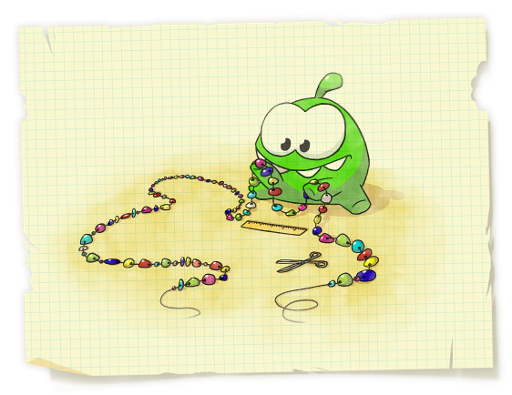One day Om Nom found a thread with n beads of different colors. He decided to cut the first several beads from this thread to make a bead necklace and present it to his girlfriend Om Nelly.

Om Nom knows that his girlfriend loves beautiful patterns. That's why he wants the beads on the necklace to form a regular pattern. A sequence of beads S is regular if it can be represented as S = A + B + A + B + A + ... + A + B + A, where A and B are some bead sequences, " + " is the concatenation of sequences, there are exactly 2k + 1 summands in this sum, among which there are k + 1 "A" summands and k "B" summands that follow in alternating order. Om Nelly knows that her friend is an eager mathematician, so she doesn't mind if A or B is an empty sequence.
Help Om Nom determine in which ways he can cut off the first several beads from the found thread (at least one; probably, all) so that they form a regular pattern. When Om Nom cuts off the beads, he doesn't change their order.
The first line contains two integers n, k (1 ≤ n, k ≤ 1 000 000) — the number of beads on the thread that Om Nom found and number kfrom the definition of the regular sequence above.
The second line contains the sequence of n lowercase Latin letters that represent the colors of the beads. Each color corresponds to a single letter.
Print a string consisting of n zeroes and ones. Position i (1 ≤ i ≤ n) must contain either number one if the first i beads on the thread form a regular sequence, or a zero otherwise.
7 2
bcabcab
0000011
21 2
ababaababaababaababaa
000110000111111000011
In the first sample test a regular sequence is both a sequence of the first 6 beads (we can take A = "", B = "bca"), and a sequence of the first 7 beads (we can take A = "b", B = "ca").
In the second sample test, for example, a sequence of the first 13 beads is regular, if we take A = "aba", B = "ba".
大致题意:给一个字符串,问该字符串的[1,i]位上的字符串能不能由A+B+A+B+......+A构成?其中k+1个A,k个B,A,B可以为空串.
分析:分别枚举A,B不大好做,但是AB可以拼起来,原题就变成了能不能用k个AB和1个A拼成,AB作为一个循环节,要先求循环节的长度,利用kmp的next数组得到.最小循环节的t倍还是循环节,记作cir,那么问题就是判断能否存在t使得i / (t * cir) = k或i = (k+1) * t*cir
(A是空串).这个问题就比较简单了,将t用i,cir,k表示,检验t是否>0并且满足条件式子.
#include <cstdio> #include <cstring> #include <iostream> #include <algorithm> using namespace std; int n, k, nextt[1000010]; char s[1000010]; void init() { int j = 0; for (int i = 2; i <= n; i++) { while (j > 0 && s[j + 1] != s[i]) j = nextt[j]; if (s[j + 1] == s[i]) j++; nextt[i] = j; } } bool check(int x) { int cir = x - nextt[x]; if (x % (k + 1) == 0 && (x / (k + 1)) % cir == 0) return true; int t = x / (k * cir); if (t > 0 && x / (cir * t) == k) return true; return false; } int main() { scanf("%d%d", &n, &k); scanf("%s", s + 1); init(); for (int i = 1; i <= n; i++) { if (check(i)) printf("1"); else printf("0"); } return 0; }